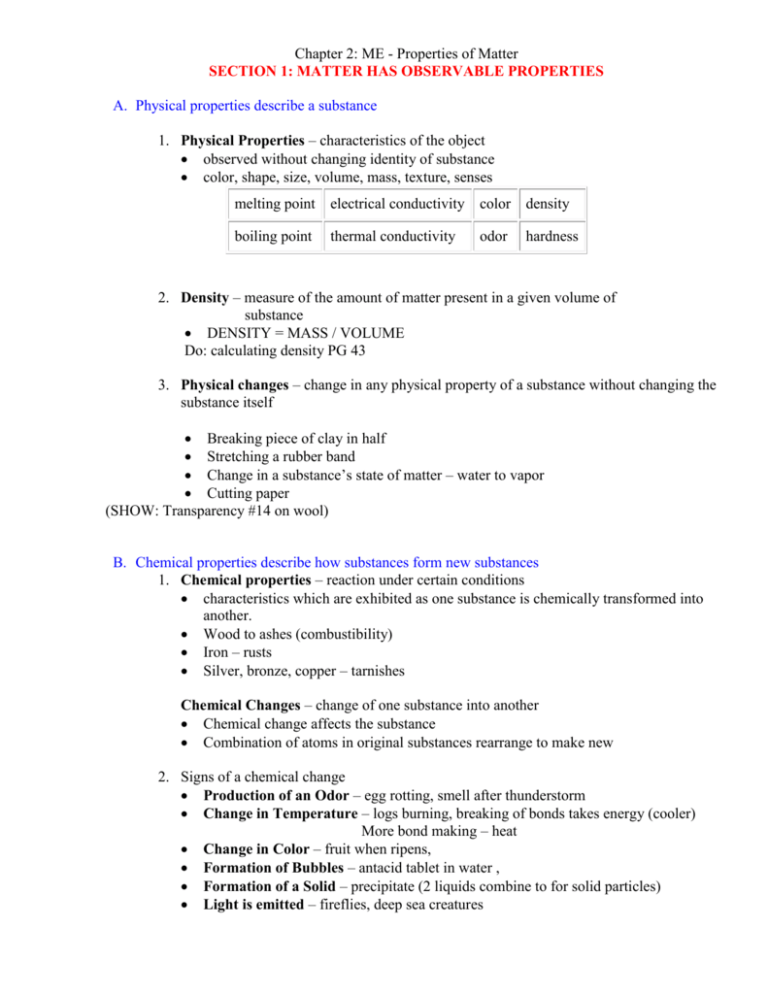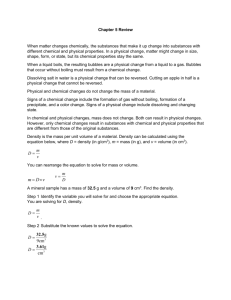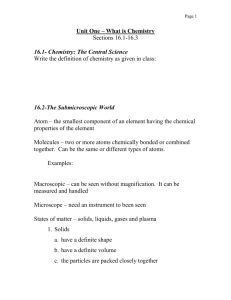SECTION 1: MATTER HAS OBSERVABLE PROPERTIES
advertisement

Chapter 2: ME - Properties of Matter SECTION 1: MATTER HAS OBSERVABLE PROPERTIES A. Physical properties describe a substance 1. Physical Properties – characteristics of the object observed without changing identity of substance color, shape, size, volume, mass, texture, senses melting point electrical conductivity color density boiling point thermal conductivity odor hardness 2. Density – measure of the amount of matter present in a given volume of substance DENSITY = MASS / VOLUME Do: calculating density PG 43 3. Physical changes – change in any physical property of a substance without changing the substance itself Breaking piece of clay in half Stretching a rubber band Change in a substance’s state of matter – water to vapor Cutting paper (SHOW: Transparency #14 on wool) B. Chemical properties describe how substances form new substances 1. Chemical properties – reaction under certain conditions characteristics which are exhibited as one substance is chemically transformed into another. Wood to ashes (combustibility) Iron – rusts Silver, bronze, copper – tarnishes Chemical Changes – change of one substance into another Chemical change affects the substance Combination of atoms in original substances rearrange to make new 2. Signs of a chemical change Production of an Odor – egg rotting, smell after thunderstorm Change in Temperature – logs burning, breaking of bonds takes energy (cooler) More bond making – heat Change in Color – fruit when ripens, Formation of Bubbles – antacid tablet in water , Formation of a Solid – precipitate (2 liquids combine to for solid particles) Light is emitted – fireflies, deep sea creatures Chapter 2: ME - Properties of Matter SECTION 2: CHANGES OF STATE ARE PHYSICAL CHANGES Where does the dew come from? Air is made of a mixture of different gases, including water vapor. Some of the water vapor condenses – or becomes a liquid – on the cool grass and forms a droplet of liquid water. A. Matter can change from one state to another Matter is found in three states – solid, liquid, and gas Substance itself does not change Arrangement of the molecules and space between them causes change Physical changes B. Solids can become liquids, and liquids can become solids. 1. MELTING – process by which a solid becomes a liquid Different solids melt at different temps Added energy as heat breaks the tight bonds between particles MELTING POINT – lowest temperature at which a substance begins to melt As solids heat up – molecules vibrate faster Molecules break loose and begin to slide past each other – liquid 2. FREEZING – process by which a liquid becomes a solid Particles lose energy and bond tightly to form a solid As temp is lowered – particles lose energy Particles move slowly enough that attraction increases FREEZING POINT – temp at which a liquid becomes a solid C. Liquids can become gases, and gases can become liquids 1. EVAPORATION – process which a liquid becomes a gas Fastest moving particles near surface break away from liquid and escape as gas As temp increases more particles escape SUBLIMATION – solid to a gas (dry ice) DEPOSITION – process by which a gas becomes a solid Chapter 2: ME - Properties of Matter 2. BOILING – process by which a liquid becomes a gas If energy as heat is added to liquid, bubbles of gas form throughout Unlike evaporation – boiling produces bubbles – dissolved air escaping Bubbles contain energetic water molecules that escaped from liquid to form gas BOILING POINT – boiling occurs when liquid reaches certain temp 3. CONDENSATION – state where gas becomes a liquid Cold can or glass cooled the surrounding air As a gas cools it loses energy – greater attraction among particles Condensed water forms when warm air containing vapor comes in contact with a cold surface If you cool a gas below its boiling point – almost all of the gas will condense DO: SECTION 2 REVIEW # 1 – 6 PAGE 55 Chapter 2: ME - Properties of Matter SECTION 3: PROPERTIES ARE USED TO IDENTIFY SUBSTANCES Texture, shape and color are physical properties used mostly to identify objects A. Substances have characteristic properties Physical and chemical properties of a substance can be used for identification Substances may share properties, no two substances have identical sets 1. Identify unknown substances – Glass of glue OR milk Can’t taste and unknown substance Rely on color, odor, texture, density, BP, FP Scientist rely on Unknown vs. Known - comparing 2. Properties used for identifying substances DENSITY: Densities of wood, plastic and steel are all different Compare density of unknown to known for identity It IS possible for two substances to have same densities Additional data needed for positive ID HEATING PROPERTIES: Substances respond to heat in different ways Aluminum and iron are good heat conductors – pots and pans Plastic, wood – poor heat conductors Measure rate at which a substance conducts heat SOLUBILITY: Measure of how much of a substance dissolves in a given volume of liquid EX: sugar and dirt ELECTRIC PROPERTIES: Allowing electric charge to move through Copper wire – good conductor Plastic and rubber – poor conductors – block the flow MAGNETIC PROPERTIES: Attraction to magnetism Iron, Steel (iron inside), Cobalt, and Nickel – magnetic Copper, Aluminum, Zinc, Plastic – NON-magnetic Chapter 2: ME - Properties of Matter B. Mixtures can be separated by using the properties of the substances in them. Substances can be separated by using differences in physical properties: A magnet will separate materials that have magnetic properties from those that don’t EX: Aluminum and steel cans at a recycling center Filtration can separate solids from liquids and can separate solids that differ in particle sizes EX: tea bags and water and screening dirt Evaporation can separate a liquid and the substances dissolved in it EX: desalination (removing salt from water), sugar from water DO: SECTION REVIEW QUESTIONS #1 – 6 PAGE 62







